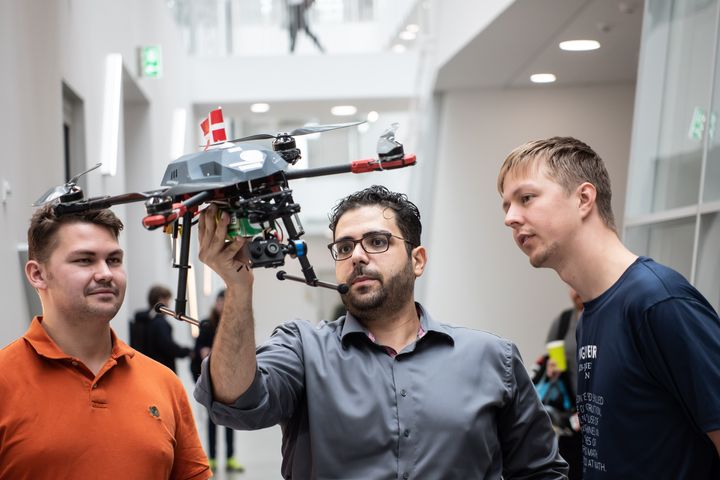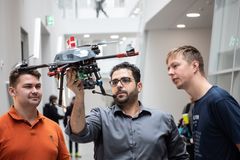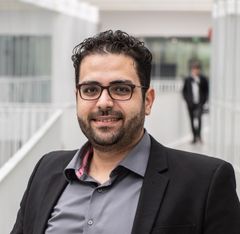New EU research project: Swarms of drones to ensure safe bridges and railways across Europe

By Jane Thoning Callesen, jtca@mmmi.sdu.dk
When the Morandi Bridge in Genoa, Italy, collapsed in August 2018, 43 people lost their lives. Three weeks later, the European Commission called for researchers to develop applications of drones to ensure safety in transport.
Now, €3,5 million has been granted to a research project called Drones4Safety. Starting today, a consortium of researchers aims to develop a system of autonomous, self-charging, and collaborative drones that can inspect infrastructures such as bridges and railways in continuous operation without direct human involvement.
Whereas the current inspection solutions are carried out by helicopters, the drone system is expected to achieve higher accuracy, reduced time and cost, and improved safety.
Drones will feed themselves from power cables
Nine partners from across Europe are involved in the project, which is coordinated by associate professor Emad Samuel Malki Ebeid from the Mærsk Mc-Kinney Møller Institute (MMMI) at the University of Southern Denmark.
- We want to create a system where swarms of drones monitor infrastructure almost by themselves and report back if they notice any problems, Emad Samuel Malki Ebeid says.
- But just like phones, drones need to charge regularly, so we must come up with a solid plan for energy harvesting.
Preliminary research has shown that 71 percent of Europe’s bridges are within three kilometers distance from high voltage power cables, and those cables can potentially be used for self-charging. The drones will also be able to “eat” from the rail cables when inspecting rails.
Comparable to a flock of birds
- You can compare the system to a flock of birds, Emad Samuel Malki Ebeid says with a smile.
- If we can get our ‘drone birds’ to eat from the power cables, they will have the energy to fly out and monitor the terrain. We will equip them with a camera, so they can see how things stand, and through artificial intelligence, we will teach them to recognize faults and cracks. Our drone birds will fly in flocks and cooperate by using geo-tracking, and then they are to notify us if something needs to be repaired.
- Drones hold so much potential, and we are interested in exploring the possibilities of energy harvesting, says Gerd Vom Bogel, dr.ing. from Fraunhofer IMS, one of the project partners.
– This project is a big step to the future, and our anticipated results on both energy harvesting, artificial intelligence, and swarm systems will likely be useful to many other application areas.
New algorithms to be developed
Teaching the drones on how to communicate with each other and work as a team will be another main challenge. Rune Hylsberg Jacobsen, associate professor from the Department of Engineering at Aarhus University, Denmark, explains how important it is for the drones to be able to cooperate on missions, work towards the same goals, and adjust to changes:
- Just like birds, the drones will each have different roles. That requires a lot of new algorithms and research, which we’re happy to contribute with. It’s great to work on such an innovative project with skilled partners from all over Europe, he says.
The artificial intelligence will partly be provided by Delair, a technology enabler providing visual intelligence solutions for enterprises.
- By contributing our AI platform to the Drones4Safety project, we look forward to paving the way for developing new advanced AI based analytics for the railways and roads market, says Paolo Guzzini, Senior Product Manager Infrastructures at Delair.
Supports the UN Goals
The project supports the UN’s Sustainable Development Goals on infrastructure and sustainable cities, and data suggests that the use of drones will reduce inspection costs by €15 billion annually.
Apart from MMMI and IMADA at the University of Southern Denmark, Aarhus University, Fraunhofer, and Delair, the project will be carried out in close collaboration with EUCentre, NEAT SL, Automotive & Rail Innovation Center, Deep Blue SRL, and Eurocontrol.
Starting in Italy, the consortium aims to conduct the first automatic drone inspections by the beginning of 2022.
- We aim to create a system that saves time and cost and ensures consistent and sustainable inspection. But most importantly, the system can potentially prevent disasters like the one we saw in Genoa, and that is a big motivation for all of us, concludes Emad Samuel Malki Ebeid.
About Drones4Safety
Drones4Safety is a major European research project under the Horizon2020-program. With a grant of €3,5 million, researchers will develop an autonomous drone system that can monitor infrastructures such as bridges and railroads. The project will run from 2020-2023.
There are five main objectives in the Drones4Safety-project: To develop a solution for energy harvesting, to increase inspection efficiency by developing AI algorithms, to provide a platform for collaborative drone operations, to develop a failsafe inspection drone, and to build a cloud-based AI system for autonomous navigation.
To view this video from sdu1.23video.com, please give your consent at the top of this page.Drones4Safety
Keywords
Contacts
For more information, footage, video, or interview requests, please contact communication manager Jane Thoning Callesen at jtca@mmmi.sdu.dk or phone +45 93507540
Images
Links
About Syddansk Universitet
Subscribe to releases from Syddansk Universitet
Subscribe to all the latest releases from Syddansk Universitet by registering your e-mail address below. You can unsubscribe at any time.
Latest releases from Syddansk Universitet
Yousif Subhi udnævnt til professor i øjensygdomme ved SDU19.12.2025 11:26:25 CET | Pressemeddelelse
Professoratet skal styrke forskningen i patientnære løsninger og ny teknologi til behandling af nethindesygdomme og bidrage til udvikling, kvalitet og ny viden på området.
SDU vil styrke fremtidens sundhedsvæsen med ny kandidatuddannelse i sundhedsøkonomi19.12.2025 10:07:21 CET | Pressemeddelelse
Syddansk Universitet vil fra sommeren 2026 udbyde en ny kandidatuddannelse i sundhedsøkonomi. Uddannelsen skal imødekomme et voksende behov for specialiseret viden om økonomi i sundheds- og velfærdsområdet.
Benjamin S. B. Rasmussen udnævnt til professor i radiologi og medicinsk teknologi ved SDU15.12.2025 14:03:46 CET | Pressemeddelelse
Professoratet skal styrke forskningen i medicinsk teknologi og bidrage til udvikling, kvalitet og ny viden på området.
194.000 har fortalt om bevægelsesvaner11.12.2025 10:32:04 CET | Pressemeddelelse
Danmark i Bevægelse har nu et unikt datamateriale, som kan bruges til at skabe bedre rammer for et aktivt liv for børn og voksne.
ERC-millioner til professor Rafsanjani: Slangerobot skal lytte sig frem i ukendt terræn9.12.2025 12:10:30 CET | Pressemeddelelse
Professor Ahmad Rafsanjani har netop modtaget en prestigefuld ERC-bevilling på 15 millioner kroner. Hans projekt vil lære bløde robotter at navigere ved hjælp af lyd, friktion og origami-teknik – en evne, der kan åbne døre til både sammenstyrtede bygninger og fjerne planeter.
In our pressroom you can read all our latest releases, find our press contacts, images, documents and other relevant information about us.
Visit our pressroom


